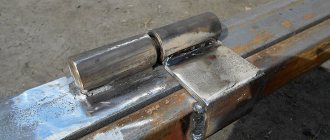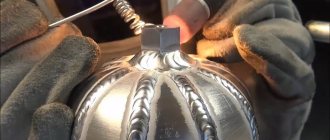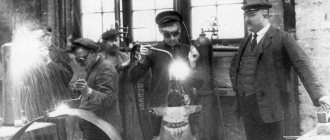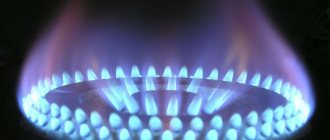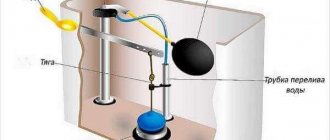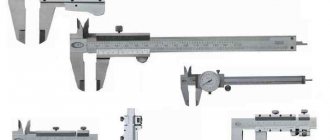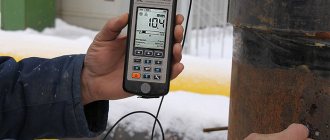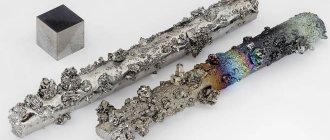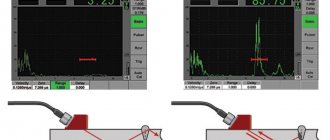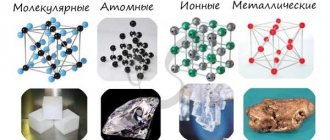Author
Posysoeva Margarita Alekseevna
Leading doctor
Ultrasound diagnostic doctor
until August 31
Comprehensive ultrasound examinations with benefits of up to 50% More details All promotions
Ultrasonography
– a modern effective and informative type of diagnostics. That is why doctors of different specialties suggest that we do an ultrasound during examination. Ultrasound data in many cases allows a more accurate diagnosis. However, ultrasound does not pose a danger to our health.
Operating principle of the devices
Ultrasonic flaw detection allows you to determine the parameters of existing defects. In particular, the distance to them can be found by estimating the propagation time of the waves. The relative size is determined by the amplitude of the reflected pulse. Ultrasonic testing equipment comes in several types.
Ultrasonic testing devices usually include several functional elements:
- High frequency pulse generator.
- Wave receiver.
- Sensor.
- The device to which measurement results are output.
Moving in a homogeneous medium, ultrasonic vibrations do not change their direction. If, for example, there is a crack along the way, some of the waves will be reflected from it, which will be recorded by the receiver. The obtained data is displayed on the monitor of the ultrasonic flaw detector. By the time of registration of reflected waves, you can find out where the defect is located and the main characteristics of the latter.
Using the device, you can carry out ultrasonic quality control of welded joints, establish the coordinates and dimensions of defects. It makes it possible to find flaws in metal and plastic products. Ultrasonic non-destructive testing allows you to detect pores, lack of fusion, and other structural defects.
Ultrasonic flaw detection
06/21/2017 Ultrasonic flaw detection is one of the non-destructive testing methods. The property of ultrasound to propagate in a homogeneous medium directionally and without significant attenuation, and to be almost completely reflected at the interface between two media (for example, metal - air), has made it possible to use ultrasonic vibrations to detect defects (sinks, cracks, delaminations, etc.) in metal parts without destroying them.
Ultrasonic flaw detection is a method that allows you to search for defects in the OC material (test object) by emitting and receiving ultrasonic vibrations reflected from internal discontinuities (defects), and further analyzing their arrival time, amplitude, shape and other characteristics using special equipment - ultrasonic flaw detectors. Nowadays, ultrasonic flaw detection, along with radiographic testing, is one of the most common methods of non-destructive testing.
The first attempts to carry out non-destructive testing using ultrasonic waves began in 1930. And 20 years later, ultrasonic quality control of welded joints has gained the greatest popularity compared to other methods of welding quality control. In addition, it has become mandatory for some products.
The most common way to excite ultrasonic waves in a controlled object and receive waves passing through the object is to use piezoelectric transducers. The inverse piezoelectric effect is used to excite waves, and the direct piezoelectric effect is used to receive them. To excite and receive waves, two separate converters can be used, or a combined converter can be used, performing the functions of an emitter and a receiver. It is usually necessary to create a layer of contact liquid between the object and the transducer, since if there is a layer of air between them, the efficiency of radiation and reception of waves will sharply decrease due to a significant difference in the acoustic resistance of the air and the controlled material (transducer material).
Ultrasonic flaw detection of welds
Welds are the most widespread area of application of ultrasonic flaw detection.
This is achieved due to the mobility of the ultrasonic installation, high testing performance, high accuracy, high sensitivity to any internal (volumetric - pores, metal and non-metallic inclusions; planar - lack of fusion, cracks), as well as external, that is, surface defects of welds (undercuts, lowering of the reinforcement roller, etc.). Ultrasonic testing of welded joints and materials is based on the ability of ultrasound to propagate in the tested product, reflecting from the boundaries of materials and internal defects. Sound waves in a homogeneous material during ultrasonic testing do not change the trajectory of movement. Defects in metal that occur during welding and casting are usually gas inclusions. Since gas has an acoustic resistance that is 5 orders of magnitude less than metal, the ultrasonic wave is almost completely reflected from the defect (provided that the size of the defect is more than half the wavelength). When the size of the defect is less than half the wavelength, the ultrasonic wave bends around the defect, that is, diffraction is observed. The resolution of ultrasonic flaw detection, that is, the minimum size of a defect that can be detected using this method, is determined by the wavelength. To increase resolution, they try to increase the frequency of oscillations used in monitoring. The disadvantage is that as the frequency increases, the penetrating power of ultrasound decreases. In this regard, the choice of oscillation frequency requires finding a certain compromise between resolution and penetration.
In ultrasonic flaw detection of welded joints, the pulse-echo testing method is mainly used. The shadow method and others are used less frequently.
Ultrasonic flaw detection methods
There are several methods of ultrasonic testing: pulse-echo, echo-mirror, echo-through, delta method (a type of echo-mirror), coherent method (a type of echo-pulse), shadow, mirror-shadow. Let's briefly consider the most common of them. 1. Pulse echo method
.
It consists of directing an acoustic wave to the welded joint and recording the reflected wave from the defect. With this method, the source and receiver of waves is one converter (scheme a) in the figure. 2. Shadow method
.
This method of ultrasonic flaw detection consists of using two transducers installed on different sides of the welded joint. With this method, one of the transducers generates acoustic waves (emitter), and the second registers them (receiver). In this case, the receiver must be located strictly in the direction of movement of the wave transmitted by the emitter. With this method, a sign of a defect is the disappearance of ultrasonic vibrations. In the ultrasonic flow, a blind area is obtained, this means that the wave in this area did not overcome the weld defect (diagram b) in the figure. 3. Echo-mirror method
.
It also consists of using two converters, but they are located on one side of the welded joint. Ultrasonic vibrations generated by the receiver are reflected from the defect and recorded by the receiver. In practice, this method has become widespread for searching for defects located perpendicular to the surface of the welded joint, for example, welded cracks (diagram c) in the figure. 4. Mirror-shadow method
. At its core, it is a shadow method, but the transducers are located not on opposite surfaces of the welded joint, but on one. In this case, it is not the direct flow of ultrasonic waves that is recorded, but the flow reflected from the second surface of the welded joint. A sign of a defect is the disappearance of reflected vibrations (diagram d) in the figure.
Ultrasonic testing principle
Ultrasonic testing of welded joints is a non-destructive welding control method and is one of the most used methods. Acoustic ultrasonic waves are capable of propagating inside a solid body to a considerable depth. Waves are reflected from boundaries or from discontinuities, because they have different acoustic properties. By directing ultrasonic waves to the welded joint using special devices - ultrasonic flaw detectors and capturing the reflected signals, pulses of the emitted and reflected waves are displayed on the flaw detector screen. By the location of these pulses and their intensity, one can judge the location of defects, their size and determine the nature of the weld defect. When inspecting welds, it is necessary to carefully sound the entire metal of the weld. There are methods of sounding with direct and reflected waves. The direct wave sounds the lower part of the seam, and the reflected wave sounds the upper part.
Parameters for assessing defects during ultrasonic testing
The sensitivity of ultrasonic testing is determined by the smallest size of the defect (or reference reflector) that can be detected. The role of reference reflectors is often played by flat-bottomed holes located perpendicular to the direction of sound, as well as side holes or notches. The resolution of the echo method is determined by the minimum distance between two defects at which they can be identified as separate defects, and not as one. During ultrasonic testing, the identified defect is assessed based on the following parameters: the amplitude of the ultrasonic wave, the conditional length, the height and width of the defect, and its shape. The conventional length of a weld defect is determined by the length of movement of the emitter along the joint, during which the echo signal emanating from the defect is recorded. In the same way, when moving the emitter normal to the welded joint, the conditional width of the defect can be determined. The conditional height is estimated based on the difference in time intervals between the emitted and reflected waves from the defect at the extreme positions of the emitter. It is very often difficult to determine the true size of a weld defect during ultrasonic testing. Therefore, most often they try to calculate its equivalent values (area or diameter). The equivalent area of a weld defect is considered to be, for example, the area of a flat-bottomed hole in a sample, the amplitude of the reflected wave from which is equal to the amplitude of the reflected wave in the weld being tested. In almost all cases, the calculated equivalent area of the defect is less than its actual area.
Advantages of the method
Ultrasonic testing of concrete and other materials is convenient because the surface being examined requires virtually no preparation. To obtain accurate data, you only need to clear the sample of paint and then lubricate it with machine oil. This is necessary for better propagation of ultrasonic pulses. Among the advantages of the method:
- It is completely safe for people around.
- The examination with a flaw detector is carried out very quickly and with great accuracy. Electronic devices allow you to get results instantly.
- Low cost.
- The equipment is compact and mobile.
- Ultrasonic testing of pipelines and other products can be carried out at an existing facility.
- Examinations with a flaw detector do not cause any damage to the object.
- The method allows you to detect flaws both on the surface of the product and inside it.
Ultrasonic testing of metal and other materials allows not only to identify defects. With its help, you can obtain data on the characteristics of the material and product parameters.
Operating principle
In a body of homogeneous structure, an acoustic wave retains its characteristics. If it is reflected, this means the presence of a medium having a different specific sound impedance. In the ultrasonic testing (UT) technique, acoustic vibrations are sent to the test sample, and when reflected, they are recorded by a flaw detector with a piezoelectric transducer. Analyzing the information received, defects are identified based on the reflection amplitude and their main characteristics are noted - configuration, depth, specific dimensional parameters.
Disadvantages of ultrasonic testing
All non-destructive testing methods have their disadvantages and limitations. Ultrasonic flaw detection is no exception. Among its disadvantages:
- It is impossible to establish the real size of the defect.
- If ultrasonic testing of metal with a coarse-grained structure is carried out, difficulties may arise. The reason is significant scattering and strong attenuation of waves.
- The need for special surface preparation before introducing ultrasonic pulses into the metal.
- The person taking measurements with the device must be highly qualified.
- If the surface of the test sample is rough, there are irregularities on it, or the product is too small in size, thickness or irregular in shape, then measurements with a flaw detector are quite difficult.
- To conduct the study, it is necessary to ensure direct contact between the product and the device.
How the data obtained is evaluated
The quality of scanning, decoding information, and accurately determining the number of flaws directly depends on the degree of sensitivity of the device. Violations are assessed according to the following indicators:
- The magnitude of the oscillation and the conventional wavelength;
- Geometric deviation parameters.
The ultrasonic testing method itself does not show the clearest characteristics of flaws, so a reference sample is needed for detailed comparison. In practice, the actual deviation area, as a rule, turns out to be larger than the parameters determined by calculations.
Ultrasonic thickness gauges
The installation of ultrasonic testing makes it possible not only to determine defects in the sample, but also to measure the thickness of the material or its paint coating without violating the integrity of the latter.
Thickness is measured using a probe that is applied to the desired point. After this, the device turns on. High-frequency vibrations, having passed through the coating and hitting the surface, are reflected from it. Most often the surface is metal. The reflected vibrations entering the sensor are analyzed, and the path traveled by the pulses is calculated.
Thus, the thickness of the coating is determined. But this method is used not only to estimate the size of a layer of varnish or paint; it is used to determine the thickness of the metal workpiece. The method has many advantages. The main one is that measurements are made without damaging the surface. It does not need to be scratched, cut, etc.
Another advantage is the ability to determine the thickness of products in which only one side is accessible for research and it is impossible to place it between the measuring bolts. For example, it is very convenient to carry out ultrasonic testing of pipes, or rather, the thickness of their walls.
An important advantage of the devices is their compactness; they can be brought to any surface under study. Measurements are made as quickly as possible; almost anyone can do this; no special skills are required, although they are welcome. There is also no need to apply physical force. Such equipment has a very affordable price.
Ultrasonic testing algorithm
The method has been used in industry for almost a century, and is used to examine the quality of welds, soldered, welded and glued joints in dissimilar metal and other samples. Such long-term popularity of ultrasonic testing of parts is explained by the accurate determination of various microdefects and deviations.
The main area of use of acoustic flaw detection is welding quality testing. To understand the ultrasonic testing algorithm, let’s consider the shadow technique, described in detail in the documentation GOST R 55724-2013.
- The seam under test and adjacent areas (up to 70 mm in each direction) are thoroughly cleaned of small contaminants.
- To increase the clarity of data indicators, the area is lubricated with glycerin, grease or special technical lubricants.
- The ultrasonic testing device is configured and calibrated taking into account the standards of a specific area.
- Emitting and receiving devices for manual ultrasonic testing are installed.
- The seam is scanned in the finder, and the device moves along its length in a zigzag manner. The reflection of a signal with maximum amplitude on the monitor indicates a violation of integrity.
- The authenticity of the presence of damage is checked and when it is established, data on the defect is entered into the registration table, which indicates:
- Uneven, cracked or insufficiently welded areas;
- The presence of delaminations or the presence of pores in the deposited metal;
- Unfused areas, fistulas;
- Corrosive changes, oxidation or sagging;
- Defects in structure and geometry characteristics.
- According to GOST requirements, after a certain number of research approaches, scanning information is recorded in a protocol and in a separate journal indicating the following indicators:
- TU for performing the study;
- Length of the suture joint under study;
- Name and type of equipment used;
- Name and index of the connection type;
- The number of oscillations per unit of time (indicated in Hz, hertz).
When performing ultrasonic testing, the determination of violations is very accurate, and the technique is in demand not only in industry, but also for private research during the construction or repair of residential or commercial facilities.
Ultrasonic inspection of welds
To ensure the safe operation of various objects that have welded seams, the latter should be periodically monitored. Various methods are used for this. Non-destructive ultrasound diagnostic method is considered one of the most effective. In terms of reliability of results, it surpasses most others.
Inspection of welded joints using ultrasonic testing has been carried out for many years, since 1930. During this time it has become very widespread and is used almost everywhere. After all, if there are even small flaws in the welds, the product may lose its strength. Subsequently, this can cause complete destruction of the connection.
Ultrasonic testing of forgings does not harm the object and is considered non-destructive. The accuracy of the result is determined by several circumstances, including the sensitivity of the device. Using flaw detectors, you can find air voids in connections, determine the presence of non-metallic elements, etc.
There are several methods for implementing ultrasonic testing. They differ from each other in the way information is recorded and evaluated. For example, the shadow method involves measuring the amplitude of pulses. This procedure can be carried out with many metals. Ultrasonic testing of cast iron, copper, steel, etc. is carried out. In addition, ultrasound helps control the hardness of metals.
Taxonomy of ultrasonic testing methods
A wide variety of technologies for ultrasonic testing of parts has led to their differentiation into active and passive.
Active methods
The essence of the technology is the direction and collection of elastic sound vibrations. These include:
- Transmission methods are the most comprehensive subgroup of methods to monitor how waves change as they pass through the area under study. It could be:
- Shadow method using two sensors, one each to generate and receive a signal.
- Mirror-shadow, helps to examine connections with two parallel sections.
- Temporary shadow - used for testing concrete, works on the principle of impulse delay.
- Velosymmetric, determining wave speed deviations.
- Echo-through, working by installing transducers one at a time on both sides of the test sample.
- Various combinations of these methods.
- The method of free vibrations caused by a directed impact of the test sample.
- Natural frequency method that records vibrations of the test area.
Passive methods
The essence of the technology of this manual ultrasonic testing is to capture and compare the vibrations that the test sample emits:
- Noise diagnostic - examines the radio spectrum of noise from a working device with the connection of microphone equipment and other devices for spectral analysis.
- Acoustic emission - suitable for studying objects that themselves emit vibrations.
- Vibration-diagnostic - for analyzing the characteristics of noise that appears during the operation of the mechanism.
The clarity of the information obtained and the effective conduct of the study depend on the correct choice of method and its competent application in a particular case.
